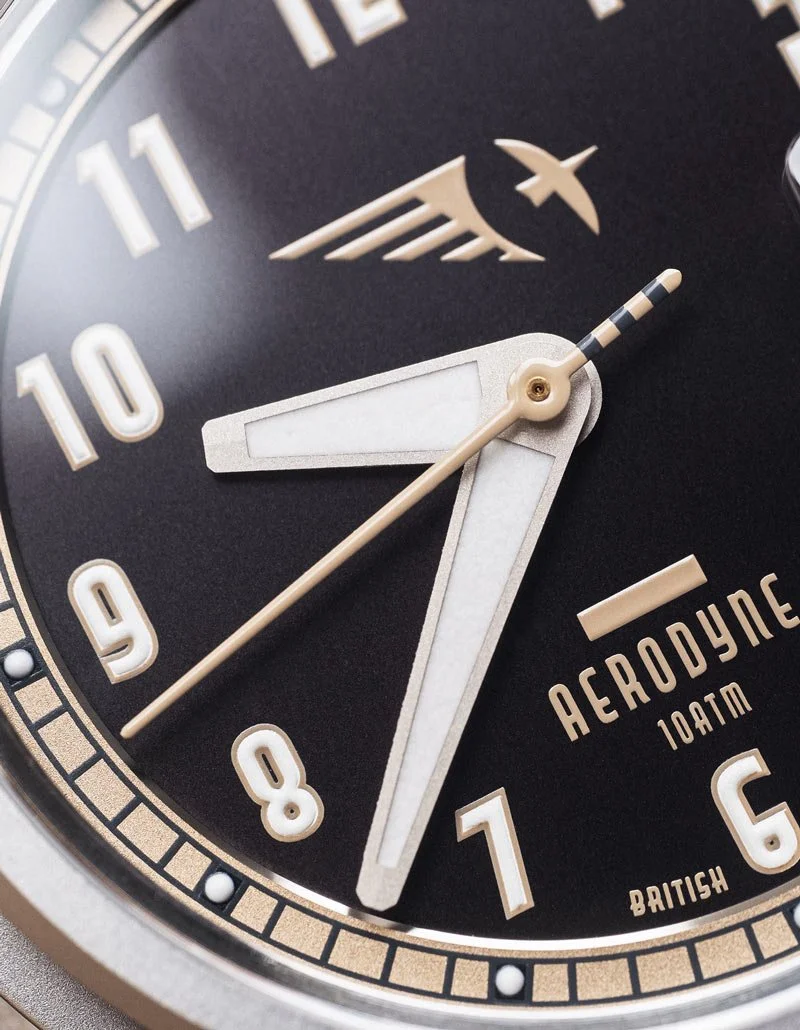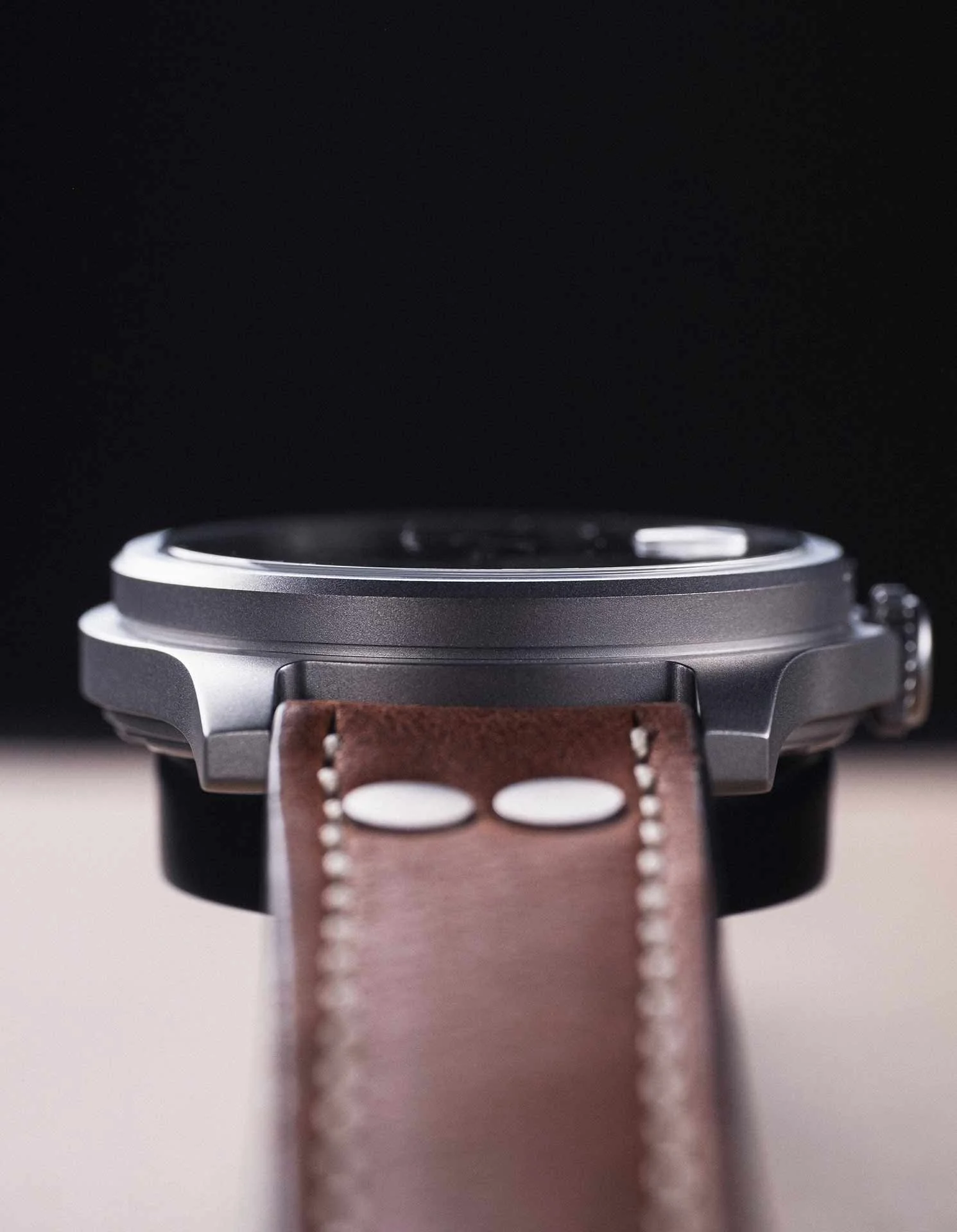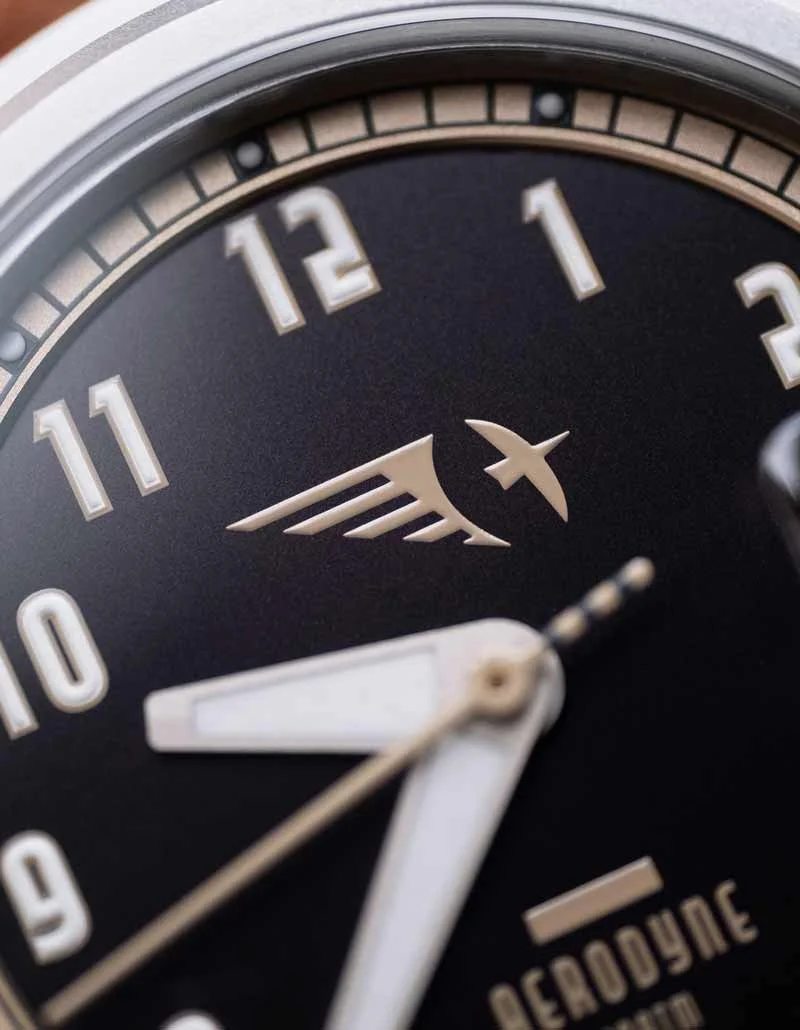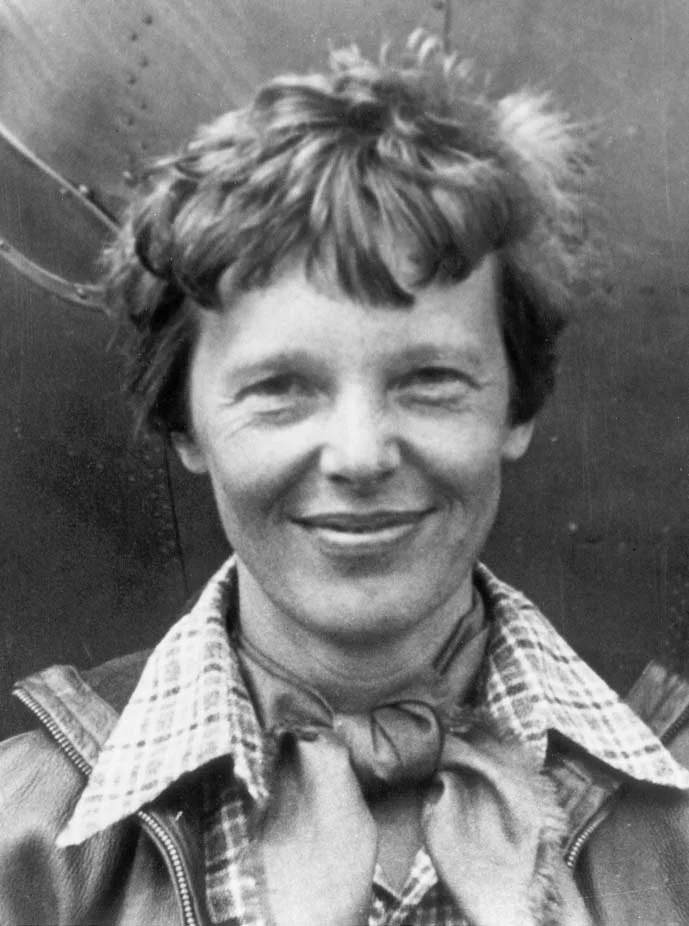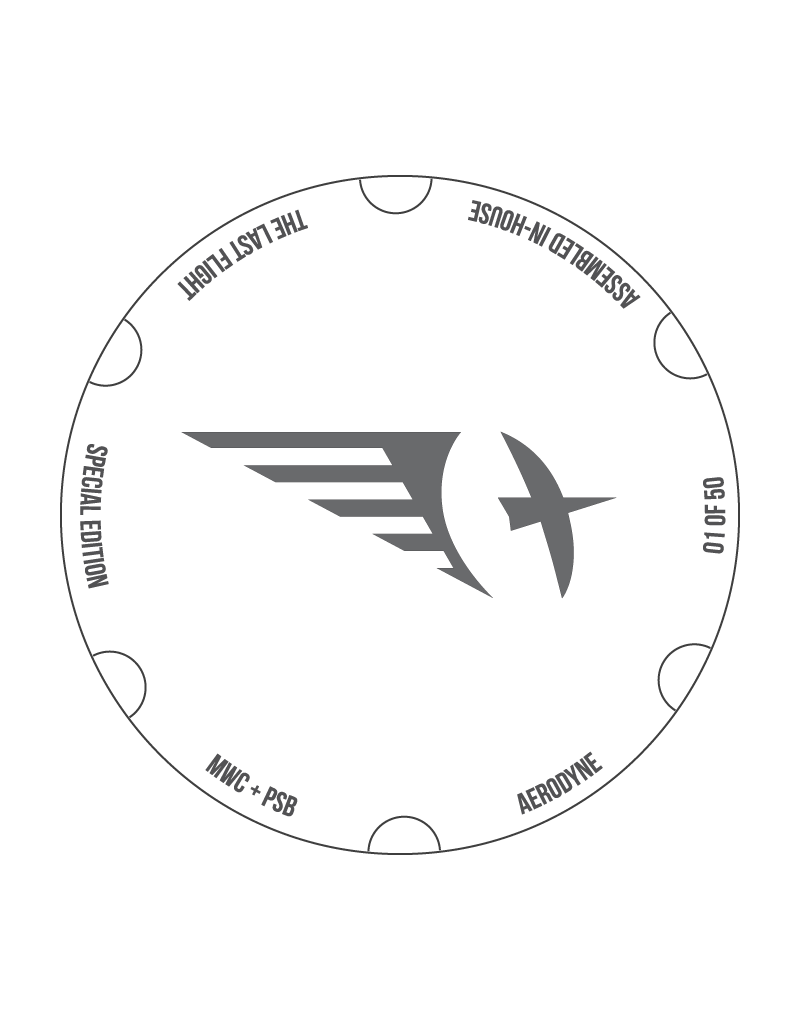
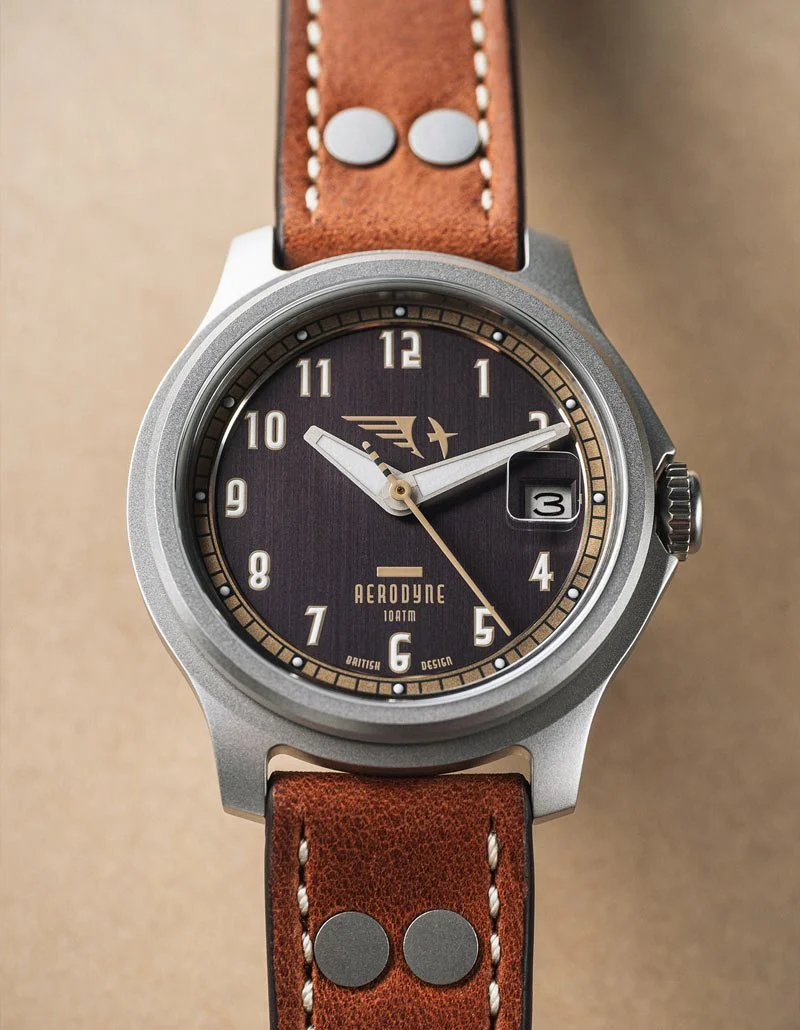
THE POWER OF MUSIC
The Aerodyne arrived like a bolt of electricity, over the course of a single day where, for the first time in over 10 years of designing unique watches, music built the foundations of our watch design.
The SkySplitter project, a pilot’s watch inspired by the fast jets that thunder over The Outpost design studio, held us in the aviation headspace enough that, when we were thinking about what watch we wanted to create next, felt like we had more to say in that arena.
“A small watch.” That’s what Oliver suggested we should focus on next, and with our pipeline of more robust, larger diameter watches, it made sense to see if we could create something neater, slimmer and more universal, but aligned to the aviation scene.
Even from the get-go, Gordon’s been looking for an opportunity to design a watch that fits into the minds-eye vision of a sun soaked airstrip in the stifling heat of chrome American aviation…Top Gun basically, but before Tom Cruise.
In search of something to listen to as he sketched ideas for a 30s chrome-heat aviation inspired aviatrix watch, Gordon found an album by Public Service Broadcasting (PSB), the band who take archival audio from a myriad of subjects, and apply it to modern music; the same band who had played a small part in the Astro design direction, via their album “The Race for Space”.
PSB had not long released an album called “The Last Flight”, which catalogued Amelia Earhart’s journey as she set off in pursuit of the record to be the first lady to circumnavigate the globe. Gordon was transfixed with the album from start to finish.
It was a perfect fit. The music inspired, the story inspired and the resonant frequencies that played together between music and design set off the spark that culminated in the watch you hold today - a small watch, but a huge watch too - as a moment in time, a place in history.
Thin and neat, the case that has been created on a lathe feels like it belongs in 30s engineering - robust and simple, yet a dial and hand-set that brings it all together in a contemporary set.
It’s remarkable: the process that made this watch was so unexpected but so powerful too, and we know that the Aerodyne is one of the finest little time-machines that we have made to date. Through the many little details to the simple wearability of it - discreet and easy to use. Even for larger wrists does the Aerodyne work, and with the dawn of fully fitted steel bracelets appearing on some of our latest watches, the Aerodyne is a robust little machine to boot.
We know you’ll love it, because as you’ll see, it’s the product of doing things as expertly as possible, not as fast as possible.
To the future, and whatever it may hold.
OLIVER GOFFE - OPERATIONS & MARKETING
There’s a reason that Marloe is regarded as the most customer-loyal and friendly watch company around. It’s because of Oliver’s unwavering commitment to doing things the right way; he could be called a perfectionist, but we prefer to call him immensely pernickety.
GORDON FRASER - CREATIVE & PRODUCTION
Design through immersion is what makes each Marloe watch unique. A professional empathiser, Gordon highlights the spirit of pioneering, human endeavour and love of discovery in everything we do. A patriotic Scotsman, lover of pretzels and whisky. Maybe jazz too.
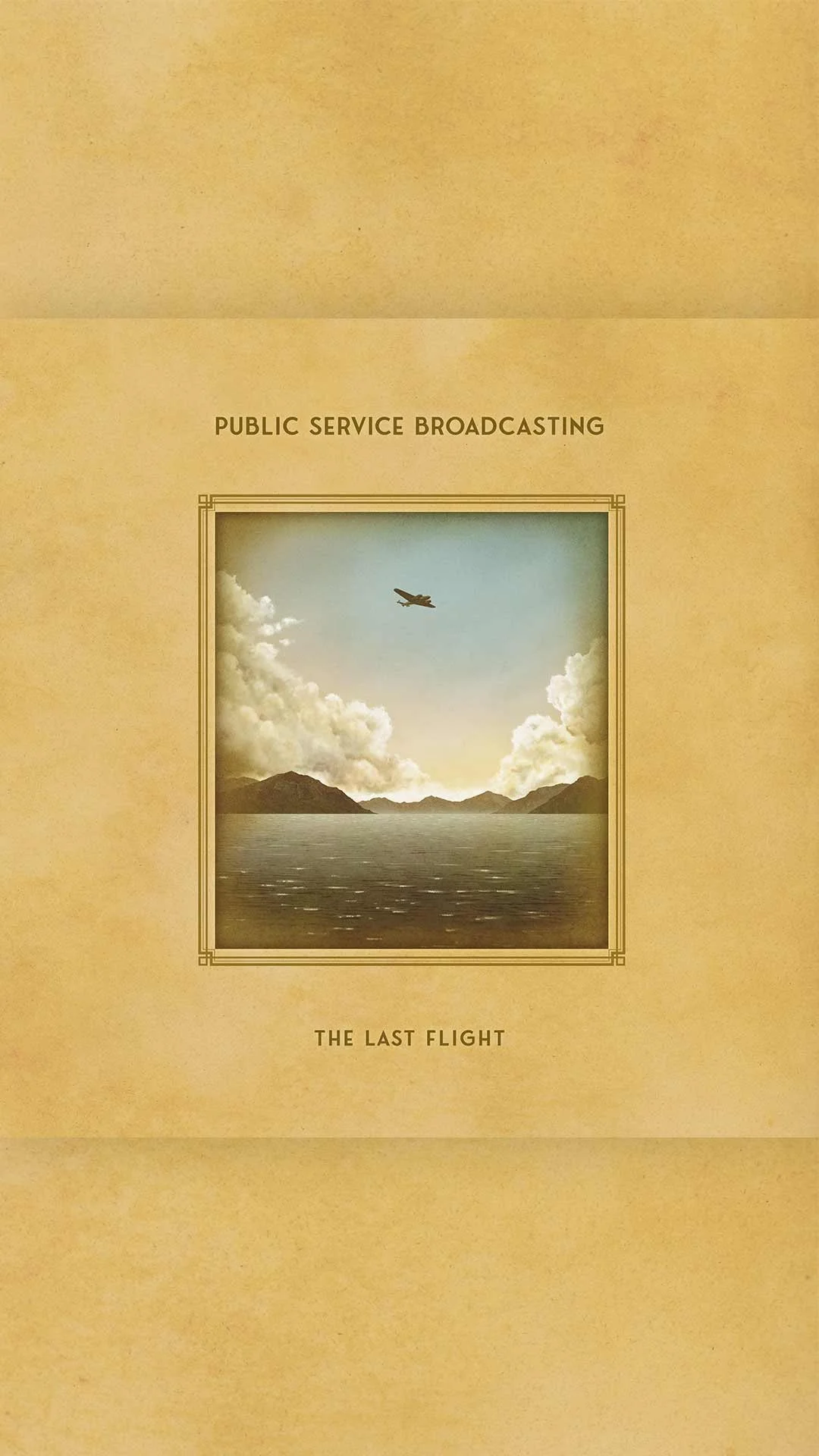
THE LAST FLIGHT
“I DO IT BECAUSE I WANT TO. I DO IT FOR THE FUN OF IT.”
Amelia Earhart was an aviation pioneer.
Her achievements, to this day, remain inspiring for people around the world, and her legacy of adventure despite the odds, continues to emit a bright beacon of courage and female empowerment.
Growing up in Atchison, Kansas, Earhart would learn to fly in 1921 before crossing the Atlantic by airplane as a passenger in 1928, becoming the first woman to do so.
Earhart then went on her own piloted adventures, crossing from Newfoundland to Northern Ireland in 1932, becoming the first solo-woman to do so, and the second person after Charles Lindbergh - she received the Distinguished Flying Cross as recognition.
A number of other record breaking solo flights secured her position as one of the leading pioneers in aviation, and her advocacy for women in aviation was as prolific - multiple books and publications, even working as aviation editor for Cosmopolitan Magazine.
It would be her most daring, ambitious pursuit that would cement her status as global icon, when she throttled-up on 1st June 1937 to take to the skies for her circumnavigation of the earth at its widest point.
This trip, the subject of PSB’s “The Last Flight”, would be her last. Having travelled, with navigator Fred Noonan, from Oakland to Miami unannounced, Earhart set her bearing for South America, heading to Natal, Brazil before crossing the Atlantic to what is now Senegal. Her route took her across Africa, into India, Burma, Indonesia and across to Australia before touching down in Papua New Guinea.
Her next destination was Howland Island, a coral island almost halfway between Australia and Hawaii - the perfect stepping stone for Earhart’s next stop in Honolulu. However adverse weather conditions and communication issues with a U.S. Coastguard ship USCGC Itasca, that had been tasked with providing navigational support for Earhart’s leg to Howland Island, meant that Earhart was lost in the gloom, unable to locate any ground locations.
Running out of fuel and increasingly desperate to establish any form of navigational position, Earhart eventually lost contact with the Itasca around 8am on 2nd July 1937. It was concluded, after one of the largest search efforts in history, and a thorough investigation, that Earhart’s Electra 10-E had run out of fuel and crashed into the ocean somewhere north of Howland Island.
The world mourned the loss of an inimitable pioneering spirit, adventurer and trailblazer in the furtherment of women’s rights and inclusion in male dominated industries.
Amelia Earhart is celebrated to this day every year in Atchison, Kansas, at the Amelia Earhart Festival. A tribute to her achievements features at the Portal of the Folded Wings Shrine to Aviation in Burbank, California.
Her life’s work and story inspires young generations to face fear, embrace the unexpected and forge new paths that go against what’s expected. A true pioneer.
PSB have captured all of this and more in their album “The Last Flight” and the way that PSB craft their music to include Amelia Earhart’s voice, the thrill of 30s aviation and the sad end to her story, has been an incredible foundation to build our work upon.

Model 10 Electra
Putting it lightly, 1938 was a fractious year for the world. Tensions rose as Nazi Germany positioned itself for war, allied forces prepared for an escalation they hoped would never come, and plans were made in the event that war, another war, did break out.
Fractious years, through a modern lens, have become almost the norm, but having gone through the horrific toll of the First World War, the prospect of heading into an even bigger war must have been, to state the obvious, frightening.
At the same time as governments were focusing on the war effort, everyone else was focusing on normalcy, and the same must be true of Lockheed Corporation, founded just 12 years earlier in 1926, as they embarked upon the development of a new commercial aircraft called the “Model 10 Electra”.
One of their students at the time, Clarence Leonard "Kelly" Johnson, was tasked with testing the prototype of the Model 10, which at the time had a single tail design. Unsatisfied that it was stable in flight, Johnson aired his grievances to deaf ears. Eventually he convinced the powers at be to change the design and, after a few other tweaks, launched the Electra to great success.
Amelia Earhart chose the Electra 10E, a heavily modified variant of the Model 10 series, for her round-the-world record attempt - more powerful engines, larger fuel tanks and an on-board laboratory to study the effects of long-distance flight.
Post-war the Electra continued to be used for internal taxi flights across the world, but the technological advancements of WWII were of such incredible leaps that the Electra was obsolete when the war ended in 1945.
Those technological leaps were in no doubt aided by the expertise and genius of one Kelly Johnson who, by 1939 had been promoted owing to his observations and tweaks to the Model 10 Electra. Johnson continued an illustrious career at Lockheed, developing many successful aircraft.
But it was his work on two aircraft in particular that many of you will know. Having developed the Skunk Works of Lockheed - the experimental development arm of the aircraft manufacturer - he developed the U2 stealth reconnaissance aircraft and, decades later, the inimitable SR-71 Blackbird.
Johnson remains to this day a celebrated pioneer in aviation, forever linked to important milestone moments of progress in both aviation, and world events.
Clarence Leonard "Kelly" Johnson
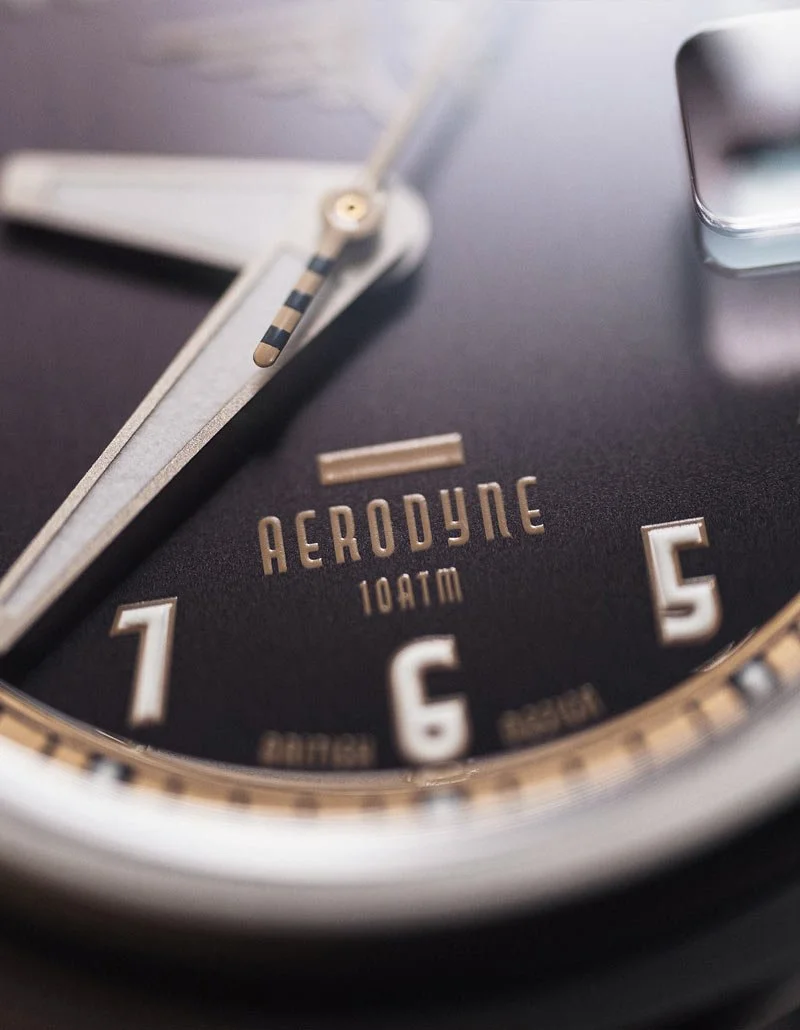
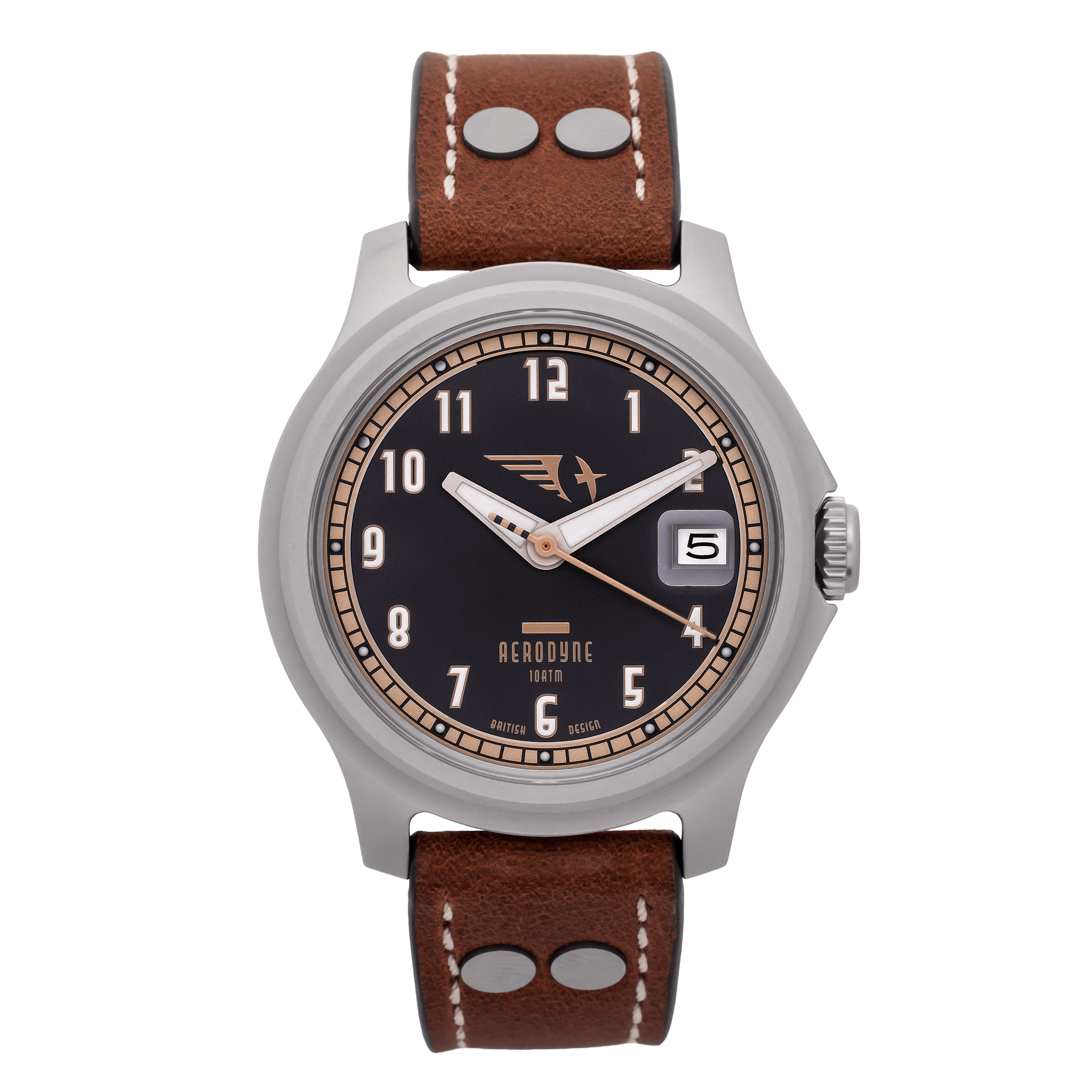
MWC+PSB
What began as an email to Public Service Broadcasting, asking delicately if we could mention that their music had inspired the Aerodyne, soon turned into a collaboration that created The Last Flight; a fully aligned PSB Aerodyne that embraces the album, its music, the sentiments and history therein. To say that we’re delighted would be an understatement.
Subtle use of sandy tones, a dark grey/brown vertically brushed dial and shimmering golden-tan accents, this isn’t just another dial, it’s another dimension of Aerodyne.
The muted tans make this feel even more era specific, and paired with the cognac pilot’s strap, makes this one of the most beautiful aviation-inspired watches we could ever have hoped to design.
In a bold move we’ve agreed to remove our logo in place of the PSB transmission motif. The crown and caseback features this motif too, with discreet text around the perimeter of the caseback. It’s still a Marloe Aerodyne, but rightfully celebrates its origin - in music made by people who celebrate the lessons of history and its pioneers, through the modern craft of music.

TURNING HEADS
The Aerodyne has been manifested from the conceptual idea of what it could have been like to live in the 1930s, as aviation - the ability to take to the skies in powered flight - found its upwards technological trajectory steepening.
To design a watch that feels like it belongs in that era, we had to think about what would feel right, when it came to the case design. Using modern methods of intricate case designs with pocket frosting or flying butress architecure, wouldn’t feel like it belonged.
Which is why we went back to absolute basics. The manufacturing technology was simpler than it is now. The age of composites and engineering alloys wouldn’t arrive for a few more years, and despite tooling metals being used, the development of cheaper, more capable metals and alloys was, like many technological leaps, spurred on by the war effort.
So the Aerodyne, we felt, needed to look and feel like it was made in the 1930s using that technology, thus we turned literally, to turning - using a lathe to create the envelope into which we cut various shapes for lugs, crowns and floating bezels.
It’s made a case that is both simple and interesting, slim yet with presence. It’s a uni-body design - one main case and one caseback - making it easy to manufacture, easy to assemble and, above all, robust.
This also limited us in a positive way, to keep the Aerodyne case simple, neat and clean. To avoid unnecessary bulk, or flourish. Straight to the point design.
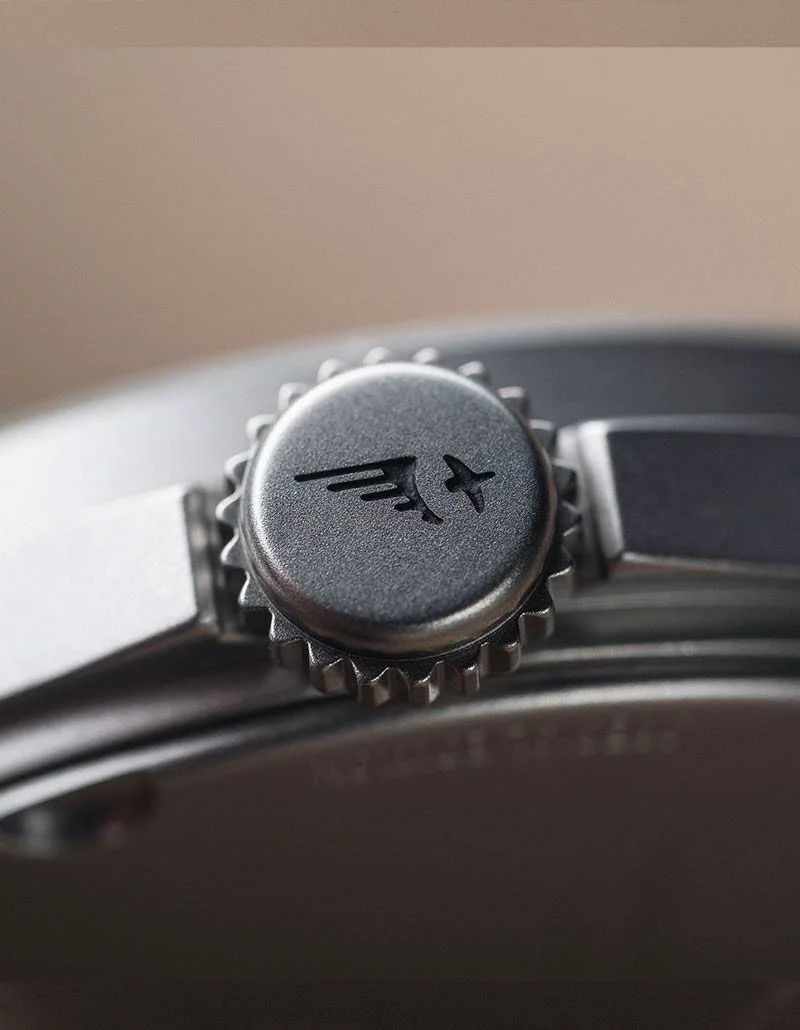
AVIATOR ALIGNED
Aviation watches typically feature several key flourishes that let you know, without doubt, this is designed for the cockpit. Usually it’s a colour scheme of black and white. Sometimes an onion-shaped crown. Almost always a matt case finish.
We always try to forge our own path when it comes to our watch design, and despite our historical off-piste, fringe approach, we’re now starting to understand that we can be both unique and integrate these long-held opinions of what a specific genre of watch should be.
The crown on the Aerodyne is a sort of hybrid design, taking the curved, bowl-like profile of an aviation onion-crown at the back, and transitioning to a button style profile at the front. In between we’ve put a simple geared grip with 24 teeth. That transition from bowl to gears to button makes this look very much like something you’d see in a cockpit, whilst retaining that element of uniqueness that sets our watches apart.

SEALING THE DEAL
We’ve maintained that seeing the mechanical movement whirling away inside the case, is a non-negotiable design requirement. We champion these marvels of micro-engineering that power our watches, accurately and reliably.
Yet the Aerodyne has a closed caseback. You can’t see anything inside. We thought about this long and hard, because to remove the window into the beating heart of a watch is to make the genius of a watch movement an ambiguous concept.
The choice was made, to make the Aerodyne a closed-back design, for two reasons:
1: Era. We wanted this to feel like it could belong in the 1930s, as Amelia Earhart took to the skies on her voyage around the world. Watches back then rarely featured exhibition case designs.
2: Prioritising thinness. A 38mm watch is only “small” if it’s thin, too. Having an exhibition caseback adds 1-1.5mm to the overall thickness of a watch, which doesn’t seem much, but when you are already bouncing off 10mm from caseback to crystal zenith, adding another 1.5mm makes a watch bulky, at 38mm diameter.
So we made it closed, made the 316L stainless steel as thin as it could be to maintain 100m water resistance, and designed a beautiful tribute to the Lockheed Model 10-E that we etched into the surface.
It’s domed, for comfort. It’s integrated and purposeful in design intent, maintaining the stepped, lathed aesthetic. It might not show you what’s inside, but it makes for an ultra-thin watch that wears beautifully, regardless of your wrist size.

MAGNIFIQUE
Small is small. Useful is useful. Opinion is opinion. Whether you like the aesthetics of a glassy, domed magnification loupe on the crystal of your watches, or not, the fact remains that it serves an essential purpose: to make the date bigger and easier to read.
We’re no spring chickens, and the date windows on our watches might be readable to most, but for failing eyesight and speed of reference, we decided to include, for the first time on any of our watches, what’s endearingly called in watchland a “cyclops”.
This little loupe magnifies the date on the Aerodyne by 120%, making what’s small, big. It’s easily readable. It’s beautifully integrated. It’s also offset ever so slightly from the date window when viewed on the z-axis which, when on-wrist and reading the date, aligns the magnifier perfectly above the date window.
Some may decry the use of a cyclops as unnecessary and demand its removal. Others thank the good design lords for their helping hand. We see it as a cool little glassy bubble that helps with time reference, creates some cool reflections and refractions, and feels like it belongs as part of a cockpit instrument.

LEGIBILITY
It’s easy to stay in our lane, especially when you’re building brands and aiming for consistency of optics. The same fonts, the same logos and the same layouts. It helps with familiarity and recognition.
The Aerodyne branches off our core system of dial fonts and layouts, to offer a refreshing take on era-specific design.
Art Deco numerals that pop out from the dial, thanks to the stacked Superluminova BG-W9, and framed with colour, project a playfulness that draws the eye in to the dial.
Textured dials, brushing and plating, level changes and negative space all combine on the Aerodyne to make this an incredibly easy dial to look at and read. Placing a train-track minute scale around a raised outer platform with a polished chamfer as it steps down onto the main dial, separates the functions.
Small pips of Superluminova BG-W9 are placed at each hour point for low-light legibility, but as daytime markers too. But it’s the balance of colour and texture that we absolutely love in the Aerodyne.

FLIGHT SURFACES
The dial screams simplicity and legibility, so the hands that our eyes search for must follow suit. A temptation to be gimmicky arises when thinking about how to fashion hands on an aviation dial - should they look like propellers, or wings, or pitot tubes, or flight instruments? There’s choices to be made.
We settled on making sure that this little dial had as much quick recognition of time position as possible, designing the hands to be simple tapered winglets with vast swathes of Superluminova BG-W9.
The hands are matched to the case finish and have a subtle peaked design - a crease down the middle with the outer edges lower down. It throws a little bit of contrast onto the hands, depending on their rotation, improving quick referencing in any lighting condition.
The seconds hand for all models is painted in a gloss paint, for a bit of 1930s feel, with a striped counter-weight for a touch of the propeller feel. It’s simple and errs on the side of plain, to avoid feeling like it’s gauch or gimmicky.
As the seconds hand sweeps smoothly around the dial, it looks absolutely wonderful.

GLOW TIME
Night falls and light dims. A watch is only useful in low light if you can read the hands and the orientation of the dial, which is why we’ve deployed a large amount of Swiss Superluminova BG-W9 onto the Aerodyne dial.
The numerals are stacked generously with luminous compound, the hands filled evenly and small pips around the chapter ring glow like little stars in the night sky. It’s a beautiful view to take in and admire. Then remember to check the time!
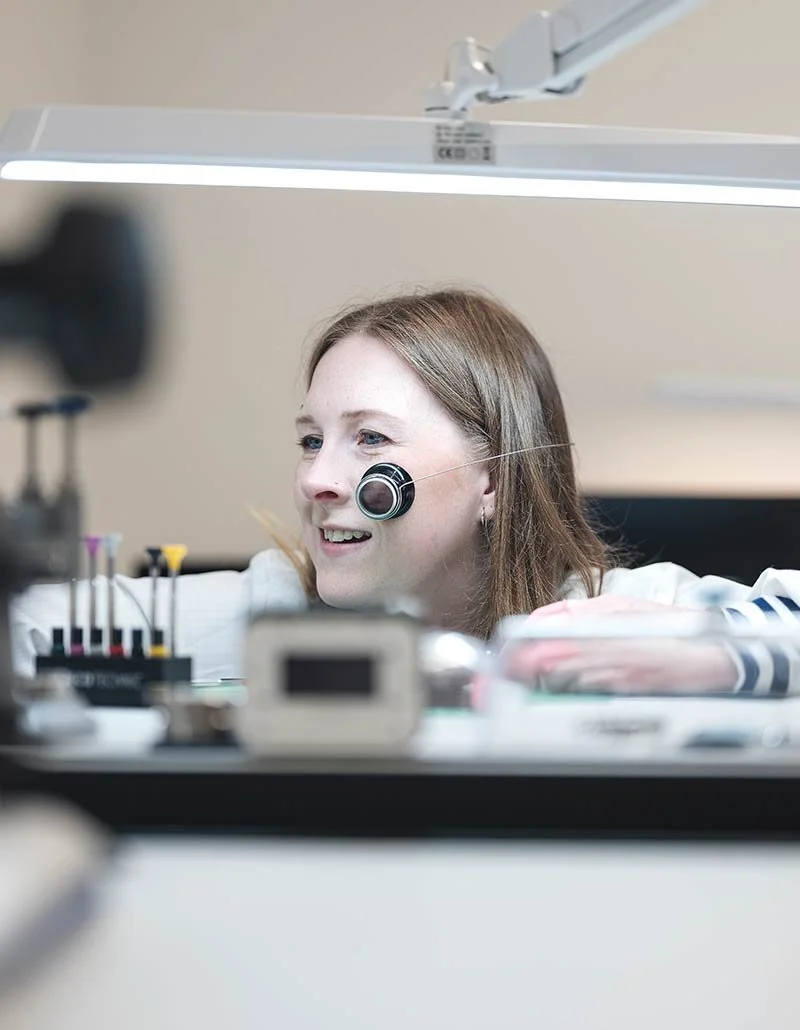
TAKING OWNERSHIP
When we began in 2015, our dream was to, one day, take control of our watch assembly. We already design and manage everything in-house, but the idea of getting kits of parts and making sure every single watch was assembled to our standards, was exciting.
10 years later and we are now realising that dream, with a team of two in our Head Watchmaker Alison, and our Chief Assembler Jaz, we now assemble everything in our HQ in Sonning Common.
The Aerodyne is the first range to be assembled in-house, and we couldn’t be more thrilled and proud of what we’ve achieved. Built in Britain is one thing. Built in-house by our watchmakers is another.
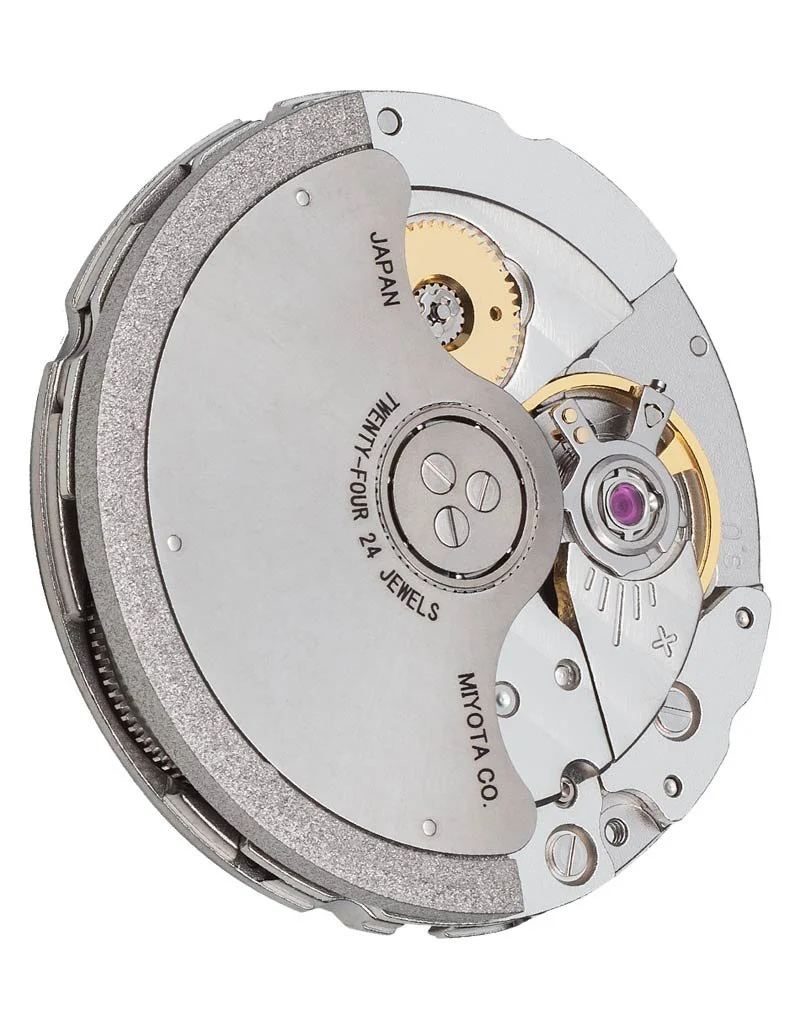
THE ENGINE
How else to say this? The Miyota 9000 series is the best mechanical movement around today, measured by cost and reliability, accuracy and availability.
This is the rock solid mechanical engine that has powered more than 6,000 of our watches so far, and we’ve never had any serious issues with them.
It’s thin. It’s accurate. It’s wonderfully simple. Yet simplicity in this context comprises 100 tiny little parts all coming together to mechanically release energy over 40+ hours to show us the time of day.
Magnificent. The Aerodyne needed a special movement, and the Miyota 9015 blasts it out of the park.

OPERATION
WINDING THE MOVEMENT
GIVING YOUR MOVEMENT ENERGY
The movement inside your is an automatic movement, which means that, so long as you move around, walk, jump or swim, the oscillating weight (rotor) will rotate around the movement and inject energy into the mainspring, keeping it topped up and running forever more.
If your movement runs out of mainspring energy, you’ll need to introduce some finger-powered charge by winding the crown clockwise in the unlocked position.
CHANGING THE DATE
MAKE SURE YOUR DATE TICKS OVER AT MIDNIGHT
Pull the crown out slowly, and gently, until you feel the first “click”. This puts your Aerodyne in the date setting function. The date can be advanced by turning the crown away from you, clockwise if looking at the crown from the side.
In order for your Aerodyne to show the correct date you must first set the date to the day before. If it’s the 10th today, set the date to the 9th.
Then move onto the next step.
CHANGING THE TIME
SETTING YOUR AERODYNE UP FOR SUCCESS
Once the date is set to the day before, pull the crown all the way outwards until it “clicks”, putting the movement into the time setting function.
Once in the time setting function, rotate the hands clockwise, all the way around the dial, until the date ticks over to the correct date. Then set the time as normal - if you’re setting the time in the morning, do so and push the crown in fully.
If you’re setting the time in the evening, make sure to cross the midday point before arriving at the time you want i.e. if it’s 9pm, turn the hands around, past 12 o’clock and keep going until you get to 9HR position. This sets the movement properly to advance the date when the hands pass midnight.
Push the crown all the way into the case, setting your Aerodyne up to run in normal operation mode.
NOTE: With any watch that features a date complication, please do not change the date, or time, between the hours of 8:30pm and 2am.

AERODYNE
38MM 1930s AVIATION INSPIRED WRISTWATCH
-
Assembled in-house
38mm diameter x 10mm depth
18mm strap width
Lathe machined, multi-step bead-blasted case
Sapphire rounded crystal with dual side anti-reflective coating
Date magnification
Turned dial with vertical brushing
Electra hour & minute hands with luminous fill
Hairline seconds hands w/counter-weight
100 Metre / 10ATM water resistance
49g (without strap)
2 year warranty
-
AUTOMATIC MECHANICAL MOVEMENT
11 1/2 ''' LIGNE
3.90MM HEIGHT
28,800BPH
42+ HOUR POWER RESERVE
HAND-WINDING CAPABILITY
24 JEWELS
HACKING SECONDS
CLOCKWISE ROTOR WINDING
ー10 ~ +30 SEC/DAY
MADE IN JAPAN
-
A mechanical movement, like a car engine, uses oils to lubricate the moving parts. Over time this fine grade of oil can become gloopy, causing your movement to lose accuracy. Every 4-5 years, think about having your watch cleaned and re-oiled by a professional - it’ll keep everything ticking along nicely.
The Aerodyne enjoys a 2-year limited warranty which covers manufacturing defects. T&C - see our website.









